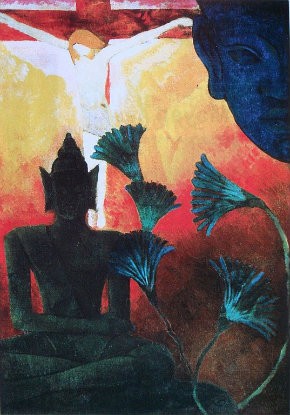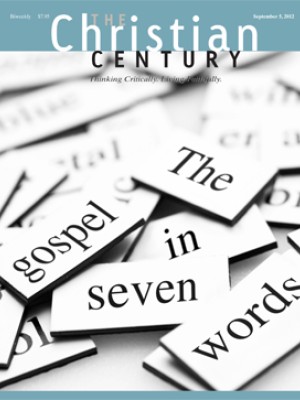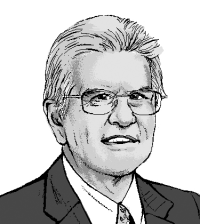Jesus meets the Buddha

A proverb that circulated in the former Soviet Union held that the future stays much the same but the past changes from day to day. Less cynically, we might say that as a society develops, people naturally develop interests in new historical topics, and academics turn their attention to these emerging issues. In the case of Christianity, the growth of churches outside the traditional West has led to an upsurge of scholarship about the early histories of African and Asian Christianity, and these histories are being written with the fresh eyes of writers from those regions.
Ever since Westerners discovered Asian cultures in the 19th century they have been intrigued by possible relationships between the two great transnational faiths, Christianity and Buddhism. In 1916, George Moore’s best-selling novel The Brook Kerith portrayed a Jesus who survived the crucifixion only to recoil from the preaching of the emerging Pauline church and eventually join a group of Buddhist monks evangelizing the Judean countryside. Many other books through the years have presented pseudo-scholarship of varying degrees of wackiness, regularly presenting a Jesus who acquires sacred wisdom in various corners of the mystic Orient.
Read our latest issue or browse back issues.
Such speculations should not for a second be confused with the solidly grounded work on Christian history and thought that has emerged from modern-day scholars who seek to give a theological basis to the Asian churches which have grown so powerfully over the past generation. Asians represent one-seventh of all Christian believers, and that number is growing mightily. Naturally, those people want to understand the Asian contexts and origins of their faith, and scholars are seeking to accommodate them.
Among theologians of Asian Christianity, we find such great Catholic figures as Aloysius Pieris and Peter Phan and Protestants like Kosuke Koyama. Asian (and Asian-American) scholars have been at the forefront of postcolonial research on the Bible—focusing on how differently non-Western readers approach the scriptural text from Euro-Americans—and the quite distinct cultural baggage the latter bring with them. The results can be startling.
One prolific author is R. S. Sugirtharajah, of Sri Lankan origin, who teaches at Birmingham University in England. Although he ranges widely in his interests, he is particularly interested in the possibility of South Asian linkages to the New Testament itself and to early Christianity more broadly. Any attempt to draw such connections has to be made cautiously, given the dismal track record of past efforts, but Sugirtharajah makes a strong case.
He shows how the campaigns of Alexander the Great brought the Hellenistic world into contact with Asian societies. Indian emissaries reached the West, while Central Asian Greeks encountered Buddhism. An early Christian interest in Indian affairs surfaces in apocryphal texts like the Acts of Thomas, and of course India’s truly ancient Christian communities proclaim Thomas as their founding evangelist. For this reason, Sugirtharajah claims the sizable body of Thomas literature as a critical tool for approaching Asian Christianity, even citing the Gnostic Gospel of Thomas as “an interesting starting point for Asian hermeneutics.”
I am usually skeptical about claims for direct Asian influences on the Mediterranean world, but one of Sugirtharajah’s examples intrigues me. In the Epistle of James, the King James translation of verse 3.6 declares that “the tongue . . . defileth the whole body, and setteth on fire the course of nature.” Different translations offer widely varying versions of the words here translated “course of nature,” but the Greek phrase is trochos tes geneseos, which can be rendered “wheel of birth.” That sounds distinctly Buddhist or Hindu, especially in the context of describing the evil effects of improper speech. As Sugirtharajah says, “If there is any influence of Eastern ideas, it is here that it is visibly prominent.”
The whole Epistle of James has attracted Asian thinkers. In his classic Water Buffalo Theology, Kosuke Koyama cited James as the most promising means of introducing Christianity to Southeast Asians, especially to Buddhists, who would feel immediately at home with its style of writing as much as its teachings. This is, he notes, just what popular Buddhist scriptures look and sound like. Asian wisdom literature sounds a lot like Judeo-Christian wisdom literature, including James but also Thomas. The Dalai Lama himself is no less enthusiastic about James, praising James’s declaration that human beings are a mist, a vapor that rises and vanishes away. What a wonderful image, he says, for the transience of human life!
Of course, none of these scholars is arguing for the existence of secret Buddhist cells in the early Jesus movement. Rather, they are pointing to the universal character of the scriptures, which were written in what was already a highly globalized world. And they are also saying that Asians, no less than Euro-Americans, have the right to read the texts in light of their own traditions.







